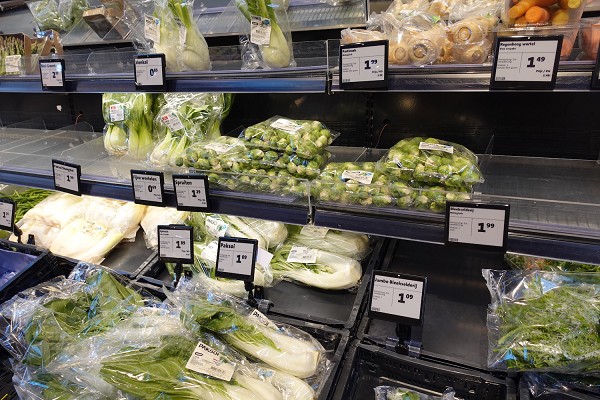Simple solutions for increasing sales and reducing food waste
Simple solutions for increasing sales and reducing food waste
Using dynamic pricing algorithms, electronic shelf labels and AI monitoring generate automated discounts for products close to expiry date. In this way retailers can both increase sales and reduce food waste.
Throwing out expired and unsold food is a problem as old as the food retail industry itself. This not only results in lost sales but is also an increasingly dramatic problem of wasting resources in a crowded world.
United Nations report that we waste 1.3 billion tons of food annually, accounting for a third of the total amount of food produced. Food waste is a cause of 6 percent of greenhouse gas emissions, three times the emissions from aviation.
As growing food involves a colossal use of water, land, labor, technology, energy, and fertilizers, food waste demonstrates an inefficient use of resources. In the conditions of growing food insecurity, food waste eventually can drive up costs, inflate food prices, and weaken the food supply chain.
Short shelf life
The food waste problem is particularly present in retail. Supermarkets generate 10.5M tons of surplus food. Due to high market competition and shifting demands, a staggering amount of products are left unsold before their expiry dates. This is especially persistent in fresh foods sections. The food surplus is often sent to local food banks or farms, but the rest (35%) simply ends up in a landfill.
Although retail only accounts for a part of the entire food waste chain, it has a strong influence over the food supply chain, the amounts, and the quality. Meanwhile, modernization of store management and inventory systems, upgrading labeling practices and creating sales insights are key solutions for minimizing retail food waste.
Turning the tables
Discounts are the most direct way of stimulating sales. If approached from a different angle, discounts are also a way to reduce food waste: seeing the lower price and the close expiration date, customers understand the deal and are more likely to purchase the product. This is called dynamic pricing; when a store adjusts its prices depending on the current situation in the market. While this helps companies optimize their margins through increased sales, it also helps reduce the annual amount of food waste by up to 10.5 million tons.
Dynamic pricing has quickly become a key feature of forward thinking retailers. However, manually updating prices for large stores is a time-consuming task, especially under widespread labor shortage conditions. Another common issue is confusion around sell-by, expiration, and use-by date labels.
Technology steps in
Using Hanshow’s SaaS network, ESLs can update prices remotely across store networks in a matter of minutes. In this way, retailers can ensure a uniform discount system across their stores and employees can find the expiration date and other use-by instructions from electronic shelf labels (ESL) from an NFC device or the backend system.
A distributor of Hanshow in Germany, Johannes Horst at Woutex shares his experience using ESL:
"Usually, on the last day of the week, food retailers had some trouble with food waste. If they close at 4 or 6 PM, they see around midday a lot of tomatoes unsold. So, they make a mega sale for the tomatoes and call it a “happy hour.” Before all price labels would have to be changed for the entire fresh food area – vegetables, milk, cheese products – overall about 2000 products. ESL makes this workflow super-fast and super easy, saving a lot of time."
A major European client of Hanshow reached a 17% reduction in tons of food waste per food sales by adopting ESL, from 5.48 tons in 2016 to 4.5 tons in 2020. This also accounts for a 17% reduction in absolute CO2 equivalent emissions. In some supermarkets, ESL and dynamic pricing helped to reduce food waste by 30%.
Going the extra mile
While ESL can provide timely, automated price updates, setting the right price and time to maximize sales across a range of products requires significant planning, and there is a notorious fine line between discounting too much or too early.
Hanshow’s AI cameras and algorithms are integrated with its ESL to allow supermarkets to monitor expiration dates, log waste and manage promotions. Hanshow’s collaboration with such tech companies as WhyWaste, Wasteless and Harb enhances the AI-learning from the customers buying habits, enabling the retailers to run better data-driven dynamic pricing policy.
Thanks to this ESL smart algorithm, retailers can significantly slash their food waste and increase sales revenues by 20% and increase net margins by 3% by reducing the time needed to manually update prices and maintain close-to-expiry pricing scenarios in a more systematic way.
Digital solutions are transforming retail operations across the board, delivering a range of benefits to the store and customer. Now as these solutions allow for dynamic pricing, these benefits are extended to the environment as well.
About Hanshow
Trusted partner to top global retailers, Hanshow provides digital retail solutions from electronic shelf labels to in-store marketing signage to AI powered monitoring for store networks. Hanshow digital retail solutions can be found in over 20,000 stores in 50 countries. Learn more about Hanshow here.



